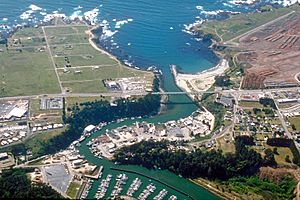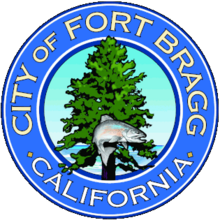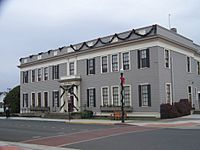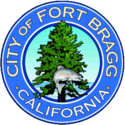Fort Bragg, California facts for kids
Quick facts for kids
Fort Bragg, California
|
||
|---|---|---|
| City of Fort Bragg | ||
 |
||
|
||
<mapframe frameless align="center" width="280" height="340" zoom="13" latitude="39.442" longitude="-123.804">[{ "type": "ExternalData", "service": "geomask", "ids": "Q108087", "properties": { "title": "Mendocino County", "description": " County seal" } }, { "type": "ExternalData", "service": "geoshape", "ids": "Q579180", "properties": { "fill": "#228B22", "title": "Fort Bragg, California", "description": "City limits  Official seal of the City of Fort Bragg" } }, { "type": "Feature", "properties": { "title": "Fort Bragg", "description": "  ", "marker-symbol": "town-hall", "marker-size": "large", "marker-color": "#800080" }, "geometry": { "type": "Point", "coordinates": [-123.8044, 39.4457] } }]</mapframe> ", "marker-symbol": "town-hall", "marker-size": "large", "marker-color": "#800080" }, "geometry": { "type": "Point", "coordinates": [-123.8044, 39.4457] } }]</mapframe> |
||
| Country | United States | |
| State | California | |
| County | Mendocino | |
| Founded as a military garrison | 1857 | |
| Incorporated | August 5, 1889 | |
| Named for | Braxton Bragg | |
| Government | ||
| • Type | Council–manager | |
| • Body | City council | |
| Area | ||
| • Total | 2.93 sq mi (7.59 km2) | |
| • Land | 2.90 sq mi (7.51 km2) | |
| • Water | 0.03 sq mi (0.09 km2) 1.1% | |
| Dimensions | ||
| • Length | 3.6 mi (5.8 km) | |
| • Width | 1.95 mi (3.14 km) | |
| Elevation | 85 ft (26 m) | |
| Population
(2020)
|
||
| • Total | 6,983 | |
| • Density | 2,383/sq mi (920.0/km2) | |
| Demonym(s) | Fort Bragger | |
| Time zone | UTC−8 (Pacific Time Zone) | |
| • Summer (DST) | UTC−7 (PDT) | |
| ZIP code |
95437
|
|
| Area code | 707 | |
| FIPS code | 06-25058 | |
| GNIS feature IDs | 1656027, 2410525 | |
| City Manager | Interim | |
| City Clerk | June Lemos | |
| Police Chief | John Naulty | |
| Fire Chief | Steve Orsi | |
| Official name | Fort Bragg | |
| Designated | July 24, 1957 | |
| Reference no. | 615 | |
Fort Bragg is a city located on the northern coast of California. It is in Mendocino County, about 24 miles (39 km) west of Willits. The city sits at an elevation of 85 feet (26 meters) above sea level. In 2020, about 6,983 people lived there.
Fort Bragg is a popular place for tourists. People visit to enjoy its beautiful views of the Pacific Ocean. Two famous spots are Glass Beach and the California Western Railroad, also known as the "Skunk Train."
Fort Bragg was started in 1857, before the American Civil War. It was a military garrison, which is a place where soldiers are stationed, not a strong fortification (a defensive building). It was named after an army officer named Braxton Bragg. He served in the U.S. Army during the Mexican–American War. Later, he joined the Confederate Army during the Civil War. Fort Bragg became an official city in 1889. It is also a California Historical Landmark.
Contents
History of Fort Bragg
The land where Fort Bragg is now was originally home to Native American people. Most of them were part of the Pomo tribe. They lived by hunting and gathering food along the northern California coast.
Early Days (1855–1867)
In 1855, a group from the Bureau of Indian Affairs looked for a place to create a reservation. A year later, the Mendocino Indian Reservation was set up near Noyo. It covered about 25,000 acres (101 km2).
In 1857, a military post was built on this reservation. It was named Fort Bragg after Captain Braxton Bragg. Soldiers stayed at the post for several years, building it up. In 1864, the military post was closed.
The Mendocino Indian Reservation was also closed in 1866. The land then became available for people to settle on. The last building from the original military post is still standing today at 430 North Franklin Street.
Growth and Lumber (1867–1892)
After the fort closed, small lumber mills began to appear. By 1873, Fort Bragg had a busy port for shipping lumber. In 1885, C. R. Johnson and his partners moved their sawmill to Fort Bragg. They wanted to use the harbor for shipping their wood.
Their company became the Fort Bragg Redwood Company in 1885. Later, it merged with another company and was renamed the Union Lumber Company in 1891. They built the Fort Bragg Railroad to carry logs to the mill.
Fort Bragg officially became a city in 1889. C. R. Johnson was its first mayor. The Weller House, built in 1886, is the oldest house in the city. Today, it is a hotel for visitors.
Challenges and Rebuilding (1893–1916)
The Union Lumber Company grew by taking over smaller lumber companies. They needed to build a tunnel to move logs from the Noyo River area. Chinese tunnel builders from San Francisco helped with this project. Many of them settled in Fort Bragg afterward.
In 1901, the Union Lumber Company started its own shipping company. This company brought important supplies like sugar and coffee to the town. In 1905, plans were made to extend the railroad all the way to Willits. This would connect Fort Bragg to San Francisco.
The 1906 earthquake caused a fire that damaged Fort Bragg. Many brick buildings were harmed, and some houses were knocked off their foundations. However, the earthquake also brought new opportunities. Fort Bragg's mills provided lumber to rebuild San Francisco. The ships returning from San Francisco brought bricks to help rebuild Fort Bragg.
With this new growth, the railroad to Willits was finished. By 1912, tourists began to visit Fort Bragg. By 1916, it was a popular place to live and visit.
Modern Times (Since 1916)
Commercial fishing has also been very important to Fort Bragg. It was once a major port known for its high-quality fish products.
The Union Lumber Company continued to operate for many years. In 1969, it was bought by Boise Cascade, and then became Georgia Pacific Lumber Company in 1973. The mill closed in 2002. The large area where the mill once stood is now being redeveloped.
Discussions About Renaming the City
In 2015, some groups asked Fort Bragg to change its name. This was because Braxton Bragg, who the city is named after, was a general in the Confederate Army. The mayor at the time, Lindy Peters, said that most residents were not interested in changing the name. He also mentioned the high cost of changing all addresses and signs.
More calls for a name change happened in June 2020. The Fort Bragg City Council discussed putting the idea on a ballot for residents to vote on. Instead, they formed a committee to look into different options. They estimated the cost of a name change would be around $271,000. One idea was to simply rededicate the city to a different notable person also named Bragg. By 2022, the committee could not agree on a name change. Meanwhile, a military fort with the same name in North Carolina was renamed to Fort Liberty.
Geography
Fort Bragg is located on the coast of California. It is about 85 feet (26 meters) above sea level.
The city covers a total area of about 2.8 square miles (7.3 km2). Most of this area is land, with a small part being water.
Climate
Fort Bragg has very mild weather all year because it is right on the Pacific Ocean. Most of the rain falls from November to April. Summers are usually dry, with only a little drizzle sometimes. Fog and cloudy skies are common, especially in the mornings.
The climate here is called a warm-summer Mediterranean climate. This means it has dry summers and mild, wet winters. Even though it's a subtropical climate, Fort Bragg has unusually cool summers compared to many other places.
Freezing temperatures happen about 11 times a year. The hottest temperature ever recorded was 91°F (33°C) in October 1987. The coldest was 18°F (−8°C) in December 1990. Winter days usually stay well above freezing.
The city gets about 43 inches (109 cm) of rain each year. Snow is very rare. It has only been recorded three times in history.
Demographics
| Historical population | |||
|---|---|---|---|
| Census | Pop. | %± | |
| 1890 | 945 | — | |
| 1900 | 1,590 | 68.3% | |
| 1910 | 2,408 | 51.4% | |
| 1920 | 2,616 | 8.6% | |
| 1930 | 3,022 | 15.5% | |
| 1940 | 3,235 | 7.0% | |
| 1950 | 3,826 | 18.3% | |
| 1960 | 4,433 | 15.9% | |
| 1970 | 4,455 | 0.5% | |
| 1980 | 5,019 | 12.7% | |
| 1990 | 6,078 | 21.1% | |
| 2000 | 7,026 | 15.6% | |
| 2010 | 7,273 | 3.5% | |
| 2020 | 6,983 | −4.0% | |
| U.S. Decennial Census | |||
In 2010, Fort Bragg had 7,273 people living in 2,812 households. About 30% of households had children under 18. Many households were married couples, while others were single-parent families or individuals living alone.
The population included people of various backgrounds. About 75% were White, and about 32% identified as Hispanic or Latino. The median age in the city was 36 years old.
Parks and Recreation
There is a walking trail that stretches over a mile along the coast. It goes north from the Noyo River Headlands. This trail offers great views of the Pacific Ocean. Along the trail, you can find signs with information about the Pomo Native Americans. You might also see harbor seals on the rocks offshore. The trail leads to a visitor center run by the Noyo Center for Marine Science.
Arts and Culture
The Guest House Museum was built in 1892. It used to be a place for the owners of the Union Lumber Company and important visitors to stay. Now, it is the home of the Fort Bragg-Mendocino Coast Historical Society. Visitors can learn about the area's history there.
The Mendocino Coast Botanical Gardens is a large garden covering 47 acres (190,000 m2). It is located along the coastal bluffs and has many different plants.
Glass Beach
Glass Beach is a unique spot on the edge of Fort Bragg. Long ago, in the early 1900s, people in Fort Bragg used to throw their garbage over the cliffs onto this beach. They threw glass, old appliances, and even cars. People called it "The Dumps."
In 1967, the city closed the area and started cleanup efforts. Over many years, the ocean waves broke down the discarded glass. They smoothed the pieces into colorful, tiny bits of sea glass that now cover the beach. Today, Glass Beach is a popular place for tourists to visit and admire the sea glass.
Other Interesting Places
- The Pudding Creek Trestle
- Noyo Harbor
- MacKerricher State Park
- Russian Gulch State Park
- Point Cabrillo Light Station
Transportation
Fort Bragg is the starting point for the California Western Railroad, also known as the "Skunk Train." This train began in 1885 to move large logs to the mills. Today, it offers scenic tours through the beautiful Coast Redwood forests.
The train got its nickname "Skunk" in 1925. This was because its original gas engines had a strong smell. People would say, "You can smell 'em before you can see 'em!" The Skunk Train is now a very popular attraction for tourists in the Fort Bragg area.
State Route 1, also called the Pacific Coast Highway, goes through Fort Bragg. It is known as Main Street within the city. This highway crosses two bridges: the Noyo River Bridge and the Pudding Creek Bridge. State Route 20 also starts in Fort Bragg. It runs east towards Willits and beyond.
The city also has a small private airport.
Education
Children in Fort Bragg attend schools in the Fort Bragg Unified School District. This includes Fort Bragg High School, Fort Bragg Middle School, Dana Gray Elementary, and Redwood Elementary. There are also some other school options available.
Notable People
- Tom Hawkins, a writer.
- Cammie King, a child actress from Gone with the Wind.
- Edward Norris, a film actor.
- Ray Peterson, an NFL player.
- Gregory E. Pyle, a former chief of the Choctaw Nation of Oklahoma.
- Jim Ross, a professional wrestling commentator.
- Cornelius Vander Starr, who founded the insurance company AIG.
- Emily Jane White, a singer.
Sister City
| Sister cities |
|---|
Fort Bragg has a sister city in Japan called Ōtsuchi, Iwate. A young man named Ken Sasaki noticed that Ōtsuchi was on the same latitude (line of imaginary measurement around the Earth) as Fort Bragg. In 2001, he contacted the mayor of Fort Bragg to discuss a sister city agreement.
Students from Fort Bragg visited Ōtsuchi in 2002. The sister city agreement was made official in 2005. There have been several student exchange programs since then. After a major earthquake and tsunami hit Ōtsuchi in 2011, Fort Bragg showed its support. The mayor ordered city flags to fly at half-staff to honor those who lost their lives.
See also
 In Spanish: Fort Bragg (California) para niños
In Spanish: Fort Bragg (California) para niños
Images for kids






